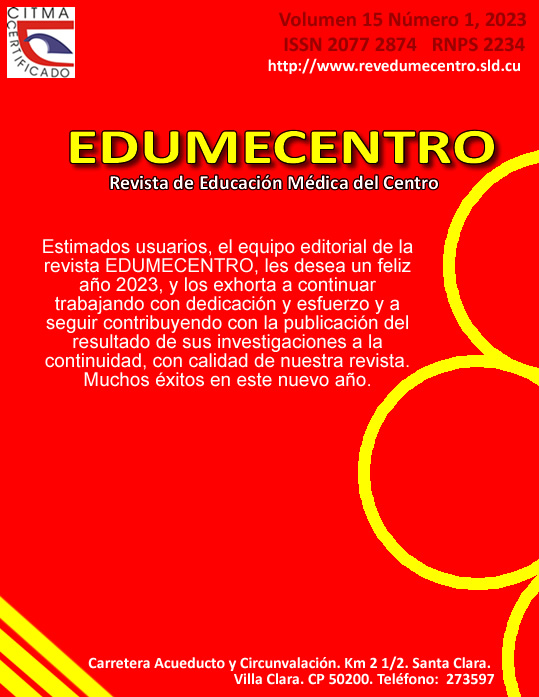The “old” electrocardiogram continues to provide new variables for medical care and education
Keywords:
Cardiology, electrocardiography, quality of health care, education, medicalAbstract
The discovery of electrocardiography marked a milestone for medicine: it offered a better understanding of cardiovascular physiology and has been an essential tool for the diagnosis, evaluation, and prognostic stratification of almost all cardiovascular diseases, and it has been an irreplaceable component of cardiology research in contemporary medicine. Important investigations of the Cardiology professorship of the "Ernesto Guevara" University Hospital have had it as an object of study in line with the guidelines of the health system, for its application in assistance and updating of specialty programs, which have been enriched with new electrocardiographic variables called "non-classical". It is the objective of the authors to communicate some novel scientific results of investigations related to this ancient aid of diagnosis, which have been published in high-impact journals.Downloads
References
1. Ministerio de Salud Pública. Dirección Nacional de Estadísticas. Anuario Estadístico de Salud 2019. [Internet]. La Habana: Minsap; 2020. Disponible en: http://files.sld.cu/bvscuba/files/2020/04/anuario-estadistico-de-salud-2019.pdf
2. Zipes DP, Libby P, Bonow RO, Mann DL, Tomaselli GF. Braunwald. Tratado de Cardiología: Texto de medicina cardiovascular. España: Elsevier Health Sciences; 2019.
3. Rodríguez F, Chávez E, Machín W, Alonso A, González V. Increased QT Interval Dispersion in Diagnosis of Acute Coronary Syndrome with Atypical Symptoms and EKG. MEDICC Review [Internet]. 2014 [citado 12/01/2023];16(3-4):[aprox. 5 p.]. Disponible en: https://www.medigraphic.com/cgi-bin/new/resumen.cgi?IDARTICULO=64162
4. Chávez-González E, González-Rodríguez E, Llanes-Camacho M, Gari-Llanes M, García-Nóbrega Y, Garcia-Sáez J. Dispersión de la onda P incrementada en niños dependiendo de la presión arterial, del peso, talla, de la estructura y función cardiaca. Arch Cardiol Mex [Internet]. 2014 [citado 16/01/2023];84(3):[aprox. 9 p.]. Disponible en: https://www.scielo.org.mx/scielo.php?pid=S1405-99402014000300003&script=sci_abstract
5. Carmona Puerta R, Chávez González E, Rabassa López-Calleja MA, Lorenzo Martínez E, Cruz Elizundia JM, Padrón Peña G, et al. Atrial conduction explains the occurrence of the P-wave dispersion phenomenon, but weakly. J Arrhythm [Internet]. 2020 [citado 25/01/2023];36(6):[aprox. 9 p.]. Disponible en:
https://www.ncbi.nlm.nih.gov/pmc/articles/PMC7733575/
6. Carmona-Puerta R, Chávez-González E, Padrón-Peña G, Cruz-Elizundia JM, Rodríguez-González F, Lorenzo-Martínez E. Uneven vectorial projection is the best explanation for QRS dispersion, not the asynchronic ventricular activation. J Electrocardiol [Internet]. 2022 [citado 12/01/2023];74:[aprox. 6 p.]. Disponible en: https://pubmed.ncbi.nlm.nih.gov/36183521/
7. Carmona Puerta R, Lorenzo Martínez E, Rabassa López-Calleja M, Padrón Peña G, Cruz Elizundia JM, Rodríguez González F, et al. Vectorial theory surpasses the local theory in explaining the origin of P-wave dispersion. J Electrocardiol [Internet]. 2021 [citado 23/01/2023];66:[aprox. 9 p.]. Disponible en: https://pubmed.ncbi.nlm.nih.gov/33962125/
8. Carmona Puerta R, Lorenzo Martínez E, Rabassa López-Calleja MA, Padrón Peña G, Castro Torres Y, Cruz Elizundia JM, et al. New parameter of the second half of the P-Wave, P-wave duration, and atrial conduction times predict atrial fibrillation during electrophysiological studies. Med Princ Pract [Internet]. 2021 [citado 25/01/2023];30(5):[aprox. 8 p.]. Disponible en: https://pubmed.ncbi.nlm.nih.gov/34348309/
Published
How to Cite
Issue
Section
License
Los autores que publican en esta revista están de acuerdo con los siguientes términos:- Los autores/as conservarán sus derechos de autor y ceden a la revista el derecho de primera publicación de su obra, el cuál estará simultáneamente sujeto a una Licencia Creative Commons Reconocimiento-NoComercial-CompartirIgual 4.0 Internacional (CC BY-NC-SA 4.0) que permite a terceros compartir la obra siempre que se indique su autor y su primera publicación esta revista.
- Los autores pueden establecer por separado acuerdos adicionales para la distribución no exclusiva de la versión de la obra publicada en la revista (por ejemplo, situarlo en un repositorio institucional o publicarlo en un libro), con un reconocimiento de su publicación inicial en esta revista.
- Se permite y se anima a los autores a difundir sus trabajos electrónicamente (por ejemplo, en repositorios institucionales o en su propio sitio web) antes y durante el proceso de envío, ya que puede dar lugar a intercambios productivos, así como a una citación más temprana y mayor de los trabajos publicados (Véase The Effect of Open Access) (en inglés).










